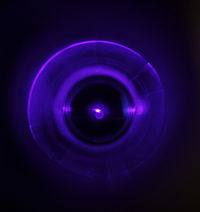Difference between revisions of "LaserCooling"
From DoyleGroup
(→Grad Students) |
(→Overview) |
||
| Line 14: | Line 14: | ||
Two-stage cryogenic buffer-gas cooled beams are an excellent precursors to laser cooling experiments as the thermal velocities of the atoms or molecules being cooled are comparable to the depth of traps (e.g., magneto-optical traps) [1-2]. In molecular systems, the buffer-gas cooled | Two-stage cryogenic buffer-gas cooled beams are an excellent precursors to laser cooling experiments as the thermal velocities of the atoms or molecules being cooled are comparable to the depth of traps (e.g., magneto-optical traps) [1-2]. In molecular systems, the buffer-gas cooled | ||
| − | beams are relevant as well because they quench internal degrees of freedom (e.g., rotational) and thus create a large number of molecules in the ground state. | + | beams are relevant as well because they quench internal degrees of freedom (e.g., rotational) and thus create a large number of molecules in the ground state. |
| + | |||
| + | |||
| + | ---- | ||
| + | '''Laser Cooling of Atoms''' | ||
| + | |||
| + | |||
| + | |||
| + | ---- | ||
| + | '''Laser Cooling of CaF''' | ||
== References == | == References == | ||
Revision as of 18:20, 30 May 2013
Contents
[hide]People
Post Docs
- Boerge Hemmerling
Grad Students
- Garrett Drayna
- Eunmi Chae
- Aakash Ravi
Overview
Two-stage cryogenic buffer-gas cooled beams are an excellent precursors to laser cooling experiments as the thermal velocities of the atoms or molecules being cooled are comparable to the depth of traps (e.g., magneto-optical traps) [1-2]. In molecular systems, the buffer-gas cooled beams are relevant as well because they quench internal degrees of freedom (e.g., rotational) and thus create a large number of molecules in the ground state.
Laser Cooling of Atoms
Laser Cooling of CaF
References
- [1] Hsin-I Lu, Julia Rasmussen, Matthew J. Wright, Dave Patterson, and John M. Doyle. Phys. Chem. Chem. Phys., 2011, DOI: 10.1039/c1cp21206k.
- [2] D. Patterson and J.M. Doyle. J of Chem Phys 126, 154307 (2007).
- [3] E. S. Shuman, J. F. Barry, D. R. Glenn, and D. DeMille, Phys. Rev. Lett. 103, 223001 (2009).
- [4] E. S. Shuman, J. F. Barry, and D. DeMille. Nature 467, 820 (2010).

